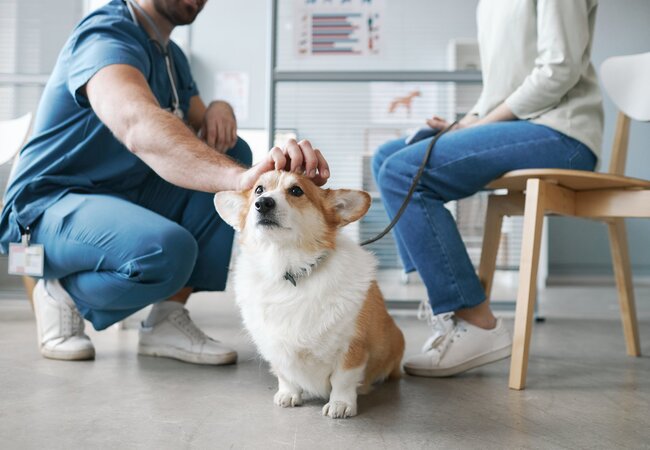2025 Vet Guide: Canine Obesity – Risks, Management & Lifelong Wellness 🐶⚖️

In this article
2025 Vet Guide: Canine Obesity – Risks, Management & Lifelong Wellness 🐶⚖️
By Dr. Duncan Houston BVSc
Nearly half of adult dogs in the U.S. are overweight or obese, which increases risk for health conditions like arthritis, diabetes, heart disease, and even shortens lifespan. This guide empowers you with causes, realistic weight-loss planning, monitoring tools, and veterinary insights for sustainable wellness. Let’s get moving! 🚶♂️
🔍 1. What Is Canine Obesity?
Obesity is defined as having at least 20% more body weight than ideal, visible on condition scoring charts (scale of 1–9). Look for minimal waist tuck, thick waist when viewed overhead, and difficulty feeling ribs under fat. Vet assessment is essential for precise evaluation.
⚠️ 2. Why It’s a Serious Health Concern
- Shortened lifespan: Overweight dogs often live significantly less, even with moderate fat excess.
- Joint & mobility issues: Extra weight and fat-driven inflammation lead to osteoarthritis and chronic pain.
- Increased anesthesia risks: Overweight dogs face complications during surgery or sedation due to dosing challenges.
- Endocrine & metabolic disease: Obesity predisposes to diabetes, Cushing’s, and fatty liver disease.
- Respiratory & cardiovascular strain: Extra mass burdens the heart and lungs, exacerbating breathing challenges.
📋 3. Causes of Weight Gain
- Excess food intake: Overfeeding, free-choice feeding, and calorie-rich treats.
- Low activity levels: Sedentary lifestyle with little exercise.
- Genetics and neutering: Certain breeds (e.g., Labs, Beagles) and neutered dogs have a higher obesity risk.
- Age and hormone changes: Slowed metabolism, endocrine disease like hypothyroidism or Cushing’s.
- Owner habits: Treating with companionship, feeding, or over-rewarding.
🛠️ 4. Designing a Safe Weight-Loss Plan
Customized, vet-supervised plans work best. Here’s how to start:
4.1 Calorie-controlled Diet
- Switch to a vet-recommended weight-loss formula higher in fiber and protein but lower in calories.
- Accurately measure meals using scales or level cups—no guesswork.
- No free feeding—only portioned meals maintain control.
- Limit treats: Swap high-calorie snacks for low-calorie veggies like green beans or carrots.
- Gradual transitions over several days to reduce GI upset.
4.2 Supplements and Medication Support
While diet and exercise are primary, some dogs benefit from:
- Zesty Paws Weight Management Bites: Fiber and B-vitamins to enhance satiety and metabolism.
- Dirlotapide (Slentrol): Vet-only appetite suppressant—requires close monitoring for side effects.
- Future options: Research is ongoing into GLP-1 analogues (Ozempic-style drugs) for pets.
4.3 Exercise & Physical Activity
- Start with gentle sessions—5–10 minute walks 2–3 times/day, increasing weekly under vet guidance.
- Consider swimming or indoor play to reduce joint stress.
- Track activity progress and adjust effort based on response.
📈 5. Monitoring and Milestones
- Weigh your dog weekly and record body condition score monthly.
- Reassess caloric needs as weight reduces.
- Regular veterinary check-ups and bloodwork every 2–3 months.
- Track joint mobility, firmness, breathing, and energy levels.
🏡 6. Long-Term Maintenance & Etiquette
- After reaching a healthy weight, shift to a maintenance formula with regular monitoring.
- Avoid “yo-yo” dieting by maintaining controlled portions and treat routines.
- Encourage lifelong activity—daily play, walks, and mental stimulation.
- Keep all household members aligned on feeding rules.
📱 7. Trusted Tools to Support Success
- Ask A Vet: 24/7 remote veterinary support to adjust diet, troubleshoot stalls, or recommend supplements.
- Woopf: Meal scheduling, weight reminders, exercise logging, and check-in prompts.
- Purrz: Track weight, body condition, energy levels, and treat intake for data-driven decision-making.
📚 FAQs
Q: How fast should my dog lose weight?
Safe loss is about 1–2% of body weight per week; too fast risks muscle loss and metabolic imbalance—monitor closely.
Q: Can older dogs exercise safely?
Yes—start slow and low-impact. Swimming or short leash walks are excellent. Always monitor joint comfort and breathing.
Q: Are treats off-limits?
Not at all! Use allocated portions from meals or offer healthy veggie treats within daily caloric budget.
💬 Owner Insight
> “Our 9‑year‑old lab weighed 70 lbs overweight. With nutritious food, measured meals, and short walks, he lost 15 lbs in 10 weeks and seems so much happier!”
🏁 Final Thoughts from Dr Houston
Obesity is a reversible condition—with commitment, veterinary guidance, and consistent monitoring, dogs can regain health, comfort, and longevity. Set realistic goals, combine diet-quality foods with measured portions and low-impact exercise, and use Ask A Vet, Woopf, and Purrz to stay accountable and informed—supporting wellness now and into 2025. 💙🐾
Download the Ask A Vet app today to start your dog’s safe weight loss journey, access expert guidance anytime, and track progress seamlessly. 📱
AskAVet.com – Helping dogs enjoy longer, healthier lives.






